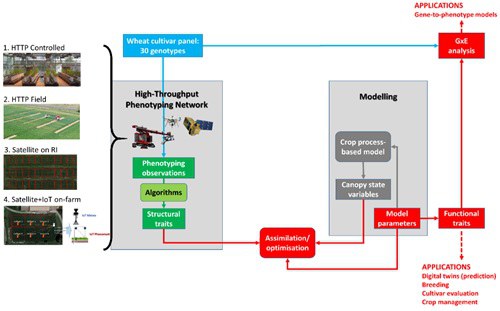UC3 GXE CEREALS
Model-assisted wheat phenotyping to predict genotype performance and adaptation to future environmental conditions
Partners: INRAE (France) – UMR LEPSE, UMR EMMAH, UE DiaScope, UE Pheno3C, UE AgroPhen, UE La Motte, UMR MISTEA (through WP4), URGI (through WP4): Agriscope (Switzerland); ETH Zurich (Switzerland) – Dep. Of Environmental Systems Science; Universidade NOVA de Lisboa (Portugal) - Plant Ecophysiology and Metabolism lab; INIAV (Portugal) –Polo de Elvas; Université Catholique de Louvain (Belgium) – Earth and Life Institute (through WP 3); Wageningen University and Research (Netherlands) - Laboratory for Geo-information Science and Remote Sensing (through WP 5); Biometris (through WP5).
Objective
The main goal of UC3 is developing a new model-assisted phenotyping strategy to improve the knowledge on genotype-by-environment (GxE) interactions of winter wheat genotypes. In model-assisted phenotyping, crop-process based models are used to identify functional traits of wheat genotypes through the assimilation of repeated multi-sensor and multi-scale observations of structural and morphological traits over a large environmental condition. The UC3 will implement such strategy in a panel of 30 wheat genotypes monitored in France, Switzerland and Portugal. The UC will cover the following specific objectives:

- Constructing a multi-scale phenotyping data acquisition framework on research infrastructure (RI) and farmer fields (on-farm-experiments, OFE) by combining high-throughput phenotyping platforms, IoT and very high-resolution satellite platforms.
- Estimating functional traits and understanding GxE interactions from the assimilation of multi-experiment and multi-environment phenotyping and envirotyping observations into a process-based crop model.
- Evaluating the contribution of cost-efficient satellite+IoT phenotyping over fields distributed in different agro-climatic conditions in the estimation of functional traits.
- Defining an ‘optimal’ experimental design based on multi-environment and multi-scale observation networks to describe GxE in wheat.
Expected results and services
- Advanced methods to analyze and predict G x E (x M) interactions
- Improved genotype-to-phenotype process-based models.
- Database to support and benchmark for future HTPP and model development.
- New traits for the breeding of climate resilient genotypes.
- Multi-scale HTPP for research and innovation.
- Innovative methods and tools for breeding and variety evaluation.
- Cost effective methods for post-registration variety evaluation and crop management (smart agriculture).


